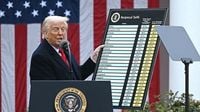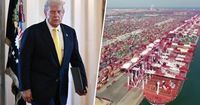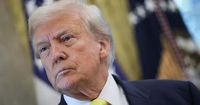It was just after midnight on August 7, 2025, when President Donald Trump’s sweeping new tariffs took effect, thrusting the United States—and much of the world—into a new era of trade uncertainty. With higher import taxes now levied on goods from more than 60 countries and the European Union, the economic ripples are already being felt, both at home and abroad. The rates? Steep: 10% or more for most, 15% for the European Union, Japan, and South Korea, and an eye-popping 20% for imports from Taiwan, Vietnam, and Bangladesh. India, singled out for its purchases of Russian oil, faces a staggering 50% total tariff after an additional 25% was announced just a day prior. And Switzerland, despite last-minute diplomatic efforts, now sees its goods hit with a 39% tariff, including on cherished exports like chocolate and pharmaceuticals. Trump’s tariffs on computer chips and semiconductors are even more dramatic, with some rates reaching 100%.
President Trump, ever bullish, declared in a late-night Truth Social post, “BILLIONS OF DOLLARS IN TARIFFS ARE NOW FLOWING INTO THE UNITED STATES OF AMERICA!” He’s touted the tariffs as a windfall that will offset the fiscal cost of tax cuts extended by Congress in June, and he’s forecasted “unprecedented” growth for the U.S. economy. “I think the growth is going to be unprecedented,” he told reporters, adding that the U.S. was “taking in hundreds of billions of dollars in tariffs,” though he admitted, “we don’t even know what the final number is.”
Yet, as the dust settles from this historic escalation in global trade tensions, many economists and business leaders are sounding alarms. According to Brad Jensen, a professor at Georgetown University, “It’s going to be fine sand in the gears and slow things down.” John Silvia, CEO of Dynamic Economic Strategy, warned, “A less productive economy requires fewer workers. But there is more, the higher tariff prices lower workers’ real wages. The economy has become less productive, and firms cannot pay the same real wages as before. Actions have consequences.”
The numbers tell a sobering story. The U.S. trade imbalance for the first half of 2025 ballooned to $582.7 billion, a 38% increase over 2024. Total construction spending has dropped 2.9% over the past year, and the manufacturing, retail, wholesale, and construction sectors—all sensitive to tariff impacts—have seen fewer job gains, according to the latest jobs report revisions. Manufacturing jobs, in particular, declined for three consecutive months from May through July. As Skanda Amarnath, executive director of Employ America, put it, “The U.S. economy appears to be hitting a mild form of stagflation. I’d call it stagflation lite.”
Stagflation—a dreaded mix of stagnation and inflation—hasn’t haunted the U.S. since the 1970s, but the risk is now front and center. The effective average tariff rate stands at 18%, the highest since 1934, according to the Yale Budget Lab. Inflation is inching up, with July’s annual rate likely rising to 2.8% from 2.7% in June, based on forecasts from economists polled by FactSet. The Consumer Price Index data, due August 12, is expected to confirm these trends. Torsten Slok, chief economist at Apollo, wrote, “The stagflation theme in markets is intensifying.”
For American families, the pinch is real. The Yale Budget Lab estimates that Trump’s new tariff rates will cost the average family about $2,400 this year. While the administration dismisses this as partisan math, even Federal Reserve Chair Jerome Powell has acknowledged uncertainty, saying last month, “There is still a long way to go to really understand exactly how” tariffs will impact the economy.
Businesses are already reacting. A May 2025 KPMG survey of 300 U.S. companies found that 77% are considering price increases of at least 5% within the next six months. Major brands like Adidas, Procter & Gamble, Walmart, Ralph Lauren, and Mattel have all warned of impending price hikes. Procter & Gamble, for instance, said it will raise prices on about a quarter of its products. Adidas has hinted at U.S. price increases in the second half of 2025 to offset rising costs. Even staples like coffee and chocolate are not immune: tariffs on Brazilian coffee could raise U.S. retail prices by 6–8% within 90 days, according to Francisco Martin-Rayo, CEO of Helios AI, while Swiss coffee and chocolate are likely to get pricier as well.
The pain won’t stop at the grocery store. Produce like tomatoes, mangoes, and avocados could see price shocks as tariffs compound existing climate disruptions. Car insurance rates may rise by the end of the year as higher tariffs increase the cost of imported parts needed for repairs. And with the U.S. importing nearly all of its clothing and footwear, shoppers may soon face higher prices on apparel and shoes. Retailers, having front-loaded inventory to delay price spikes, may see their buffer run out by late summer or early fall, according to David Warrick of Overhaul, a supply chain risk firm.
Globally, the tariffs are causing headaches for U.S. trading partners. Germany, which sends 10% of its exports to the U.S., saw industrial production drop 1.9% in June. In India, the Federation of Indian Export Organizations warned that the new tariffs will affect nearly 55% of the country’s outbound shipments to America, forcing exporters to lose long-standing clients. “Absorbing this sudden cost escalation is simply not viable. Margins are already thin,” said S.C. Ralhan, the group’s president. Switzerland’s Federal Council scrambled to Washington in a failed bid to avert the 39% tariffs, and now faces steep duties on key exports.
Despite these warning signs, the White House remains steadfast. Spokesman Kush Desai downplayed the risk of stagflation, telling CBS MoneyWatch, “Inflation continuing to remain cool and growth rebounding in Q2 both suggest stagflation is simply the latest buzzword for panican paranoia.” ("Panican," by the way, is a term President Trump coined to mock critics’ fears.) Trump himself, aware of legal challenges to his use of a 1977 law to declare an economic emergency and impose tariffs, took to Truth Social to say, “THE ONLY THING THAT CAN STOP AMERICA’S GREATNESS WOULD BE A RADICAL LEFT COURT THAT WANTS TO SEE OUR COUNTRY FAIL!”
On Wall Street, the S&P 500 index has climbed more than 25% since its April low, buoyed by the rebound and Trump’s tax and spending package signed into law on July 4. Yet, Carsten Brzeski, global chief of macro for ING bank, cautioned, “While financial markets seem to have grown numb to tariff announcements, let’s not forget that their adverse effects on economies will gradually unfold over time.”
As the world watches and waits, the only certainty is uncertainty. For now, Trump’s tariffs are reshaping the global economic order, raising costs, and testing the resilience of American consumers and businesses alike. Whether the promised boom materializes—or the risks of stagflation and economic slowdown become reality—remains to be seen.



